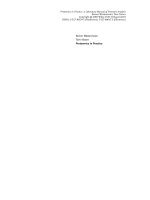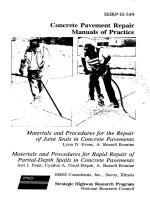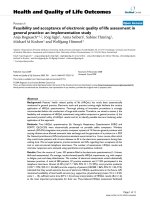electronic practice manual
Bạn đang xem bản rút gọn của tài liệu. Xem và tải ngay bản đầy đủ của tài liệu tại đây (2.74 MB, 31 trang )
<span class="text_page_counter">Trang 1</span><div class="page_container" data-page="1">
1
TON DUC THANG UNIVERSITY
FACULTY OF ELECTRICAL-ELECTRONICS ENGINEERING
DIVISION OF ELECTRONICS-TELECOMMUNICATIONS
ELECTRONIC PRACTICEManual
Edited by Division of Electronics-Telecommunication (Internal only)
</div><span class="text_page_counter">Trang 2</span><div class="page_container" data-page="2">2
CONTENT
Unit 1 Electronic Workshop Regulation Introduction Devices and Measured Equipments.<b>––</b> .... 4
1.1. Electronic workshop regulations ... 4
1.2. Introduction about electronic devices and equipment and how to use them. ... 4
1.3. Electronic measurement devices and equipment. ... 5
1.4. Practice procedure ... 8
1.5. Report ... 8
Unit 2 Identification and Testing Some Electronic Basic Components<b>–</b> ... 9
2.1. Identification and reading value of resistor ... 9
2.2 Identification and reading value of capacitor. ... 11
2.3 Identification and reading value of inductor. ... 13
2.4 Identification and test some of diode. ... 14
2.5 Identification and transitor. ... 15
2.6. Practice procedure ... 16
2.7. Report ... 17
Unit 3 Soldering technology<b>–</b> ... 18
3.1. Soldering using method ... 18
3.2. Soldering procedure ... 18
3.3. Three join-wire soldering method ... 18
3.4. Component disassembled technology ... 19
3.5. Component soldering technology ... 19
3.6. Practice procedure ... 20
Unit <b>4 –</b> Electronic circuit diagram restore ... 21
4.1. Board only one layer ... 21
4.2. Carrying out principle diagram from board only one layer ... 21
4.3. Board with two layers ... 21
4.4. Carrying out principle diagram from board only one layer ... 21
4.5. Practice procedure ... 22
Unit 5 Using project board- Assembling some rectifier circuits.<b>–</b> ... 24
5.1. Finding out of project board ... 24
5.2. Assembling half-wave rectifier circuit and testing ... 24
5.3. Assembling full-wave rectifier circuit and testing ... 25
5.4. Assembling full-wave rectifier circuit and testing ... 25
5.5. Practice procedure ... 25
Unit 6 Design a circuit board - Assembling voltage regulator circuit.<b>–</b> ... 27
</div><span class="text_page_counter">Trang 3</span><div class="page_container" data-page="3">3
6.1. Draw circuit line on paper from priciple diagram ... 27
6.2. Draw circuit line on paper from priciple diagram ... 27
6.3. Assemble DC voltage regulator and testing ... 27
6.4. Practice procedure ... 28
Unit 7 Unstable oscillator circuit with transitor.<b>–</b> ... 29
7.1. Draw circuit line on paper from priciple diagram ... 29
7.2. Draw circuit line on paper from priciple diagram ... 29
7.3. Assemble DC voltage regulator and testing ... 29
7.4. Practice procedure ... 30
REFERENCE ... 31
</div><span class="text_page_counter">Trang 4</span><div class="page_container" data-page="4">
4
Unit 1 Electronic Workshop Regulation Introduction Devices and <b>––</b>
Measured Equipment.
UNIT OBJECTIVE
✓ Student masters electric safety, industrial manners.
✓ Know how to use some basic device as well as keep them in good condition. ✓ Use familiarly all of measurement equipment.
1.1. Electronic workshop regulations
Every student who want to do at electronic workshop is forced to read and know well electronic workshop regulations’ (Electronic workshop regulations’ board is been hanging in the wall of every workshop).
1.2. Introduction about electronic device and equipment and how to use them. 1. Electric soldering-iron
• Introduction all of electric soldering-iron available in the market • Introduction all of electric soldering-iron available in the workshop
2. Electric soldering-iron rack 3. Colophony and soldering wire • All of soldering wire available in the market • Colophony and when as well as how to use them. 4. Pincers
</div><span class="text_page_counter">Trang 5</span><div class="page_container" data-page="5">5 7. Tweezers, magnifi er
8. Soldering pump
9. All of screwdriver • A set of screw-driver • Flat blade screwdriver • Cross blade screwdriver
1.3. Electronic measurement devices and equipment.
There are four basic equipment used in electronic measurement as follows. 1. Analog Volt-Ohm meter (VOM)
2. Digital-Multi-Meter (DMM)
</div><span class="text_page_counter">Trang 6</span><div class="page_container" data-page="6">6 3. Analog and digital oscilloscope
How to use VOM
••••• Ohm measurement (cooling measurement)
When starting, we need to fasten two measure stick heads together, after that setting the pointer turn to zero( when we change measurement range, we must to do this action).
• While carrying out the measurement, do not leave your hand touching the measured stick head.
• Result reading method of resistor value: reading on display screen, direction contrariwise with voltage and current measurement.
• Reading at the highest line.
A R’s value= red value multiply by measurement range ••••• Measure VAC and VDC ( hot measurement)
Note:
1. Set VOM range right to function needing to measure (VAC,VDC…)
2. Estimate the value of measured unit to set the measurement range, if not we must to set the measurement highest range from large scale then lower it gradually.
</div><span class="text_page_counter">Trang 7</span><div class="page_container" data-page="7">7 3. When measuring VDC , need to notice the pole of measured unit.
4. Two measurement stick head must be touch right measured position with a moderate press, specially do not leave it touched another position.
Measured value equal measured range divide by red range value, and then multiply by the pointer value
Example: select measurement range is 0.5V, read following by 50 line, the pointer value is 3.7. we get the measured value equal( (0.5)/50)3.7=0.37V
Current: given circuit as fig.1 .2
Value reading metho
The same voltage value reading method.
</div><span class="text_page_counter">Trang 8</span><div class="page_container" data-page="8">8 1.4. Practice procedure
1. Device preparation • Some kind of resistor, varistor • Power supply set
2. Procedure
• Use VOM to measure all of the resistor
• Use VOM to measure VDC and VAC of power supply set in variety scale and range. 1.5. Report
1. Draw measured circuit diagram. 2. Take notes the measured results. Review question
Exercises: measure VDC through each resistor as given circuit
VR1=? VR2=? VR3=? Remark and discussion?
Preparation • Reading the unit 2
• Finding out of some devices related to next lesson
</div><span class="text_page_counter">Trang 9</span><div class="page_container" data-page="9">
9
Unit 2 Identification and Testing Some Electronic Basic Components <b>–</b>
UNIT OBJECTIVE
✓ Student identifies some electronic components.
✓ Know how to test and check them as well as some regularly damaged situation. ✓ Some concerned parameter when using these components.
2.1. Identification and reading value of resistor 1. Resistor
Symbol:
Types of resistor • Carbon resistor • Ceramic resistor • Wire-round resistor • Power resistor… Identification
Res-carbon power resistor
Value reading wire-round resistor • Resistor with four color bands
</div><span class="text_page_counter">Trang 10</span><div class="page_container" data-page="10">10 • Resistor with five color bands
Color band value board
</div><span class="text_page_counter">Trang 11</span><div class="page_container" data-page="11">11 • Tolerant letter
• Multiply letter
• Some of resistor join method - Series
- Parallel
• Some of damaged resistor situation - Broken
- Increase value 2. Varistor
Symbol
Real Figure .
2.2 Identification and reading value of capacitor 1. Capacitor
3
</div><span class="text_page_counter">Trang 12</span><div class="page_container" data-page="12">12 • Nonpolar capacitor
• Polar capacitor
• Identification and reading value
• Some of capacitor join method - Series
- Parallel
• Some of damaged capacitor situation - Dry
- Broken 2. Variable capacitors
</div><span class="text_page_counter">Trang 20</span><div class="page_container" data-page="20">20 • Step 5: Cleaning and cover soldering on spot need to solder.
• Step 6: Fixing soldering spot • Step 7: Do soldering act
• Step 8: Make cool the soldering join.
• Step 9: Checking soldering join, durability, fineness, mechanical bond, dimension, measuring conductance with surrounding advice.
3.6. Practice procedure 1. Device preparation • Soldering iron device, iron rack. • Soldering wire, colophony • Circuit board available
• Emery paper, tweezers, knife, soldering pump. • Diode 1N4007,1N4148, Zener, LED..
2. Procedure
• Student carries out device disassemble procedure step by step out of supported board. • Student carries out soldering disassembled device into the board. Noting that solder rightly the
same as previous board.
• Student can do it many times to update soldering skill as well as make sure about fine arts and technique of soldering join.
3. Report
• Report gotten results and given out remark.
• Teacher considers and evaluates student’s act, technical and fitness of every soldering join. • Soldering junction must be sure strongest and flat, spend the smallest soldering wire. • Connection wire and component must be bent perpendicularly.
Review question Exercises: Let’s advance soldering method Remark and discussion?
Preparation • Reading the unit 4
• Finding out of some devices related to next lesson.
</div><span class="text_page_counter">Trang 21</span><div class="page_container" data-page="21">draw back principle diagram.
✓ Training observation skill on types of available board to draw back if necessary. 4.1. Board only one layer
Theory basic
Procedure may be done as follows:
• Step 1: Student is supplied one board with a lot of electronic components
• Step 2: Relying on available line on board, draw back it on paper exactly and honestly. • Step 3: Basing on step 2 to determine what the circuit is.
4.2. Carrying out principle diagram from board only one layer Practice
• Receiving a real board from teacher and conduct draw back (the same board two layer)
4.3. Board with two layers Theory basic
• The same as board only one layer
4.4. Carrying out principle diagram from board only one layer
• Receiving a real board from teacher and conduct draw back front side on paper
</div><span class="text_page_counter">Trang 22</span><div class="page_container" data-page="22">22 • And then draw back back side of board on paper
• Connect all of components on paper as real line on board • Replace real components by their symbol
• Make straight all of line and put all of symbol reasonably. • Considering it again and name it following duty of circuit.
4.5 Practice procedure . 1. Device preparation
• Board one layer and board two layer for every student 2. Procedure
• Student receives board from teacher and carries out drawing principle diagram
3. Report
• Report gotten results and given out remark.
• Draw rightly principle diagram with arranging components reasonably, in good-looking. Review question
</div><span class="text_page_counter">Trang 23</span><div class="page_container" data-page="23">23 Exercises: Why must we draw back the principle diagram?
Remark and discussion?
Preparation • Reading the unit 5
• Finding out of some components related to next lesson.
</div><span class="text_page_counter">Trang 24</span><div class="page_container" data-page="24">component a certain circuit. or5.1. Finding out of project board
Project board structure
• Project board is a plug base with many holes using to put electronic component into such as IC, resistor, capacitor, wire… getting them together to form a circuit that is able to operate convenient for making practicing circuit or characteristic of a certain electronic component. • Project board has flat form with plastic base. All plug holes are brass sheet with tweeter
structure using to clamp component plots when putting it into holes.
• Project board consists of four parts: two small parts at two sides, two big parts at center. A small part is used to form cross node or power supply spot. A remainder is used to plug electronic component and wire.
• Two adjacent holes’ distant is about 0.1 inch equivalent two adjacent plots of one IC .Two big parts’ distant is 0.3 inch equivalent distant of two plot lines of DIP 300 IC.
Note: Please, do not plug component or wire having plot greater than hole diameter. 5.2. Assembling half-wave rectifier circuit and testing
• Assemble given circuit
• Using VOM and Oscilloscope to get output value, compare between input and output waveform. Do it in two cases with and without capacitor C1.
• Remark and discussion.
</div><span class="text_page_counter">Trang 25</span><div class="page_container" data-page="25">25 5.3. Assembling full-wave rectifier circuit and testing
• Assemble given circuit
• Using VOM and Oscilloscope to get output value, compare between input and output waveform. Do it in two cases with and without capacitor C 1.
• Remark and discussion.
5.4. Assembling full-wave rectifier circuit and testing • Assemble given circuit
• Using VOM and Oscilloscope to get output value, compare between input and output waveform. Do it in two cases with and without capacitor C 1.
• Remark and discussion. 5.5. Practice procedure
</div><span class="text_page_counter">Trang 26</span><div class="page_container" data-page="26">26 Review question
Exercises: Compare results in circuit with and without capacitor C 1? Remark and discussion?
Preparation • Reading the unit 6
• Finding out of some devices related to next lesson.
</div><span class="text_page_counter">Trang 27</span><div class="page_container" data-page="27">Unit 6 Design a circuit board - Assembling voltage regulator circuit. <b>–</b>
UNIT OBJECTIVE
✓ Supporting student masters regulations in design procedure of circuit board .
✓ Arrange component reasonably. Straight line must thin and straight. Cross line must be perpendicular.
✓ Supporting student knows strengths and weaknesses of product making himself. Servicing for final subject
6.1. Draw circuit line on paper from principle diagram Note
• Simplifying diagram if necessary
• Every component plots must be had private soldering hole.
• Circuit line could been able to cross through two component plot but component must not lied cover together.
• All circuit lines do not cross together in principle diagram, the reality do the same. 6.2. Draw circuit line on paper from principle diagram
After finishing circuit line board on paper, we conduct real circuit board as follows: • Step 1: Using thin emery paper polish oxidized layer in brass side of board before drawing
circuit line. Stick paper with finishing circuit lines into brass side, then using pointed material to mark plot of components.
• Step 2: Using uncorrectable pen draw line connecting all plot basing mark position and principle diagram. Looking on it carefully again, if having a certain line faded or not continuous, we must be mended it, if necessary, we must draw overlapping another line. Noting that do not lack any line and line thick must be the same.
• Step 3: Waiting until drying ink, bring it to soak into chemical substance Chemical substance . will be wear out brass position without ink.
• Step 4: After finishing unnecessary brass erasure. we soak it into water and polish cleanly drew ink with thin emery paper. Component plot will be drill with 0.8 mm drill bit. Another case could be used machine to make holes.
• Step 5: At last, polish it again with thin emery paper. Then dip it in colophony mixed with petrol. Dry it, cover it with the paint. Now we can use it to solder electronic compoments.
6.3. Assemble DC voltage regulator and testing • Given circuit priciple
</div><span class="text_page_counter">Trang 28</span><div class="page_container" data-page="28">28 • Designing circuit line board form principle
• Conducting ink line board following precious procedure
• Spread soldering wire and assemble electronic component into board • Power on and checking its operation.
• Using VOM to check output terminal .
• Turn varistor and checking the change of output voltage. • Adjust and mend if it do not operate.
6.4 Practice procedure . 1. Device preparation
• Chemical substance, cutting knife, emery paper, uncorrectable pen, soldering wire, colophony, drill bit 0.8mm, sew cape, water sink, rule, experiment power supply.
• Ink board with 8 multiply by 8 cm dimension per one person. • All needed components in lesson.
• Comparing theorical and real result.
• Taken reason influencing to circuit voltage regulator quality. .
• Finding out of some devices related to next lesson. Compone nt Quantity
</div><span class="text_page_counter">Trang 29</span><div class="page_container" data-page="29">• Simplifying diagram if necessary
• Every component plots must be had private soldering hole.
• Circuit line could been able to cross through two component plot but component must not lied cover together.
• All circuit lines do not cross together in principle diagram, the reality do the same. 7 . Draw circuit line on paper from principle diagram .2
After finishing circuit line board on paper, we conduct real circuit board as follows: • Step 1: Using thin emery paper polish oxidized layer in brass side of board before drawing
circuit line. Stick paper with finishing circuit lines into brass side, then using pointed material to mark plot of components.
• Step 2: Using uncorrectable pen draw line connecting all plot basing mark position and principle diagram. Looking on it carefully again, if having a certain line faded or not continuous, we must be mended it, if necessary we must draw overlapping another line. Noting that do not lack any line and line thick must be the same.
• Step 3: Waiting until drying ink, bring it to soak into chemical substance. Chemical substance will be wear out brass position without ink.
• Step 4: After finishing unnecessary brass erasure, we soak it into water and polish cleanly drew ink with thin emery paper. Component plot will be drill with 0.8 mm drill bit. Another case could be used machine to make holes.
• Step 5: At last, polish it again with thin emery paper. Then dip it in colophony mixed with petrol. Dry it, cover it with the paint. Now we can use it to solder electronic compoments.
7.3. Assemble DC voltage regulator and testing • Given circuit priciple
</div>








